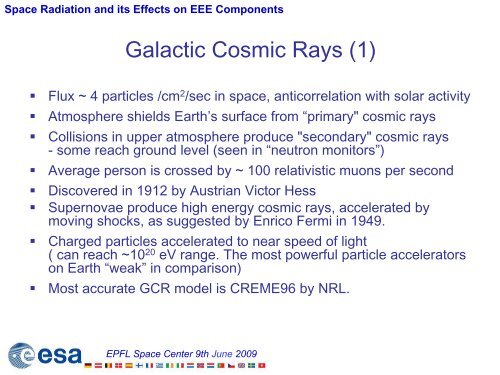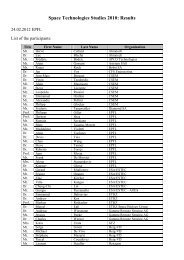Space Radiation and its Effects on EEE Components
Space Radiation and its Effects on EEE Components
Space Radiation and its Effects on EEE Components
You also want an ePaper? Increase the reach of your titles
YUMPU automatically turns print PDFs into web optimized ePapers that Google loves.
<str<strong>on</strong>g>Space</str<strong>on</strong>g> <str<strong>on</strong>g>Radiati<strong>on</strong></str<strong>on</strong>g> <str<strong>on</strong>g>and</str<strong>on</strong>g> <str<strong>on</strong>g>its</str<strong>on</strong>g> <str<strong>on</strong>g>Effects</str<strong>on</strong>g> <strong>on</strong> <strong>EEE</strong> Comp<strong>on</strong>ents<br />
Galactic Cosmic Rays (1)<br />
� Flux ~ 4 particles /cm 2 /sec in space, anticorrelati<strong>on</strong> with solar activity<br />
� Atmosphere shields Earth’s surface from “primary" cosmic rays<br />
� Collisi<strong>on</strong>s in upper atmosphere produce "sec<strong>on</strong>dary" cosmic rays<br />
- some reach ground level (seen in “neutr<strong>on</strong> m<strong>on</strong>itors”)<br />
� Average pers<strong>on</strong> is crossed by ~ 100 relativistic mu<strong>on</strong>s per sec<strong>on</strong>d<br />
� Discovered in 1912 by Austrian Victor Hess<br />
� Supernovae produce high energy cosmic rays, accelerated by<br />
moving shocks, as suggested by Enrico Fermi in 1949.<br />
� Charged particles accelerated to near speed of light<br />
( can reach ~10 20 eV range. The most powerful particle accelerators<br />
<strong>on</strong> Earth “weak” in comparis<strong>on</strong>)<br />
� Most accurate GCR model is CREME96 by NRL.<br />
EPFL <str<strong>on</strong>g>Space</str<strong>on</strong>g> Center 9th June 2009



